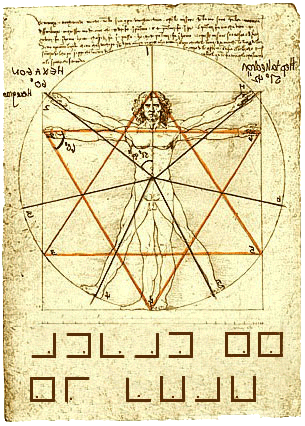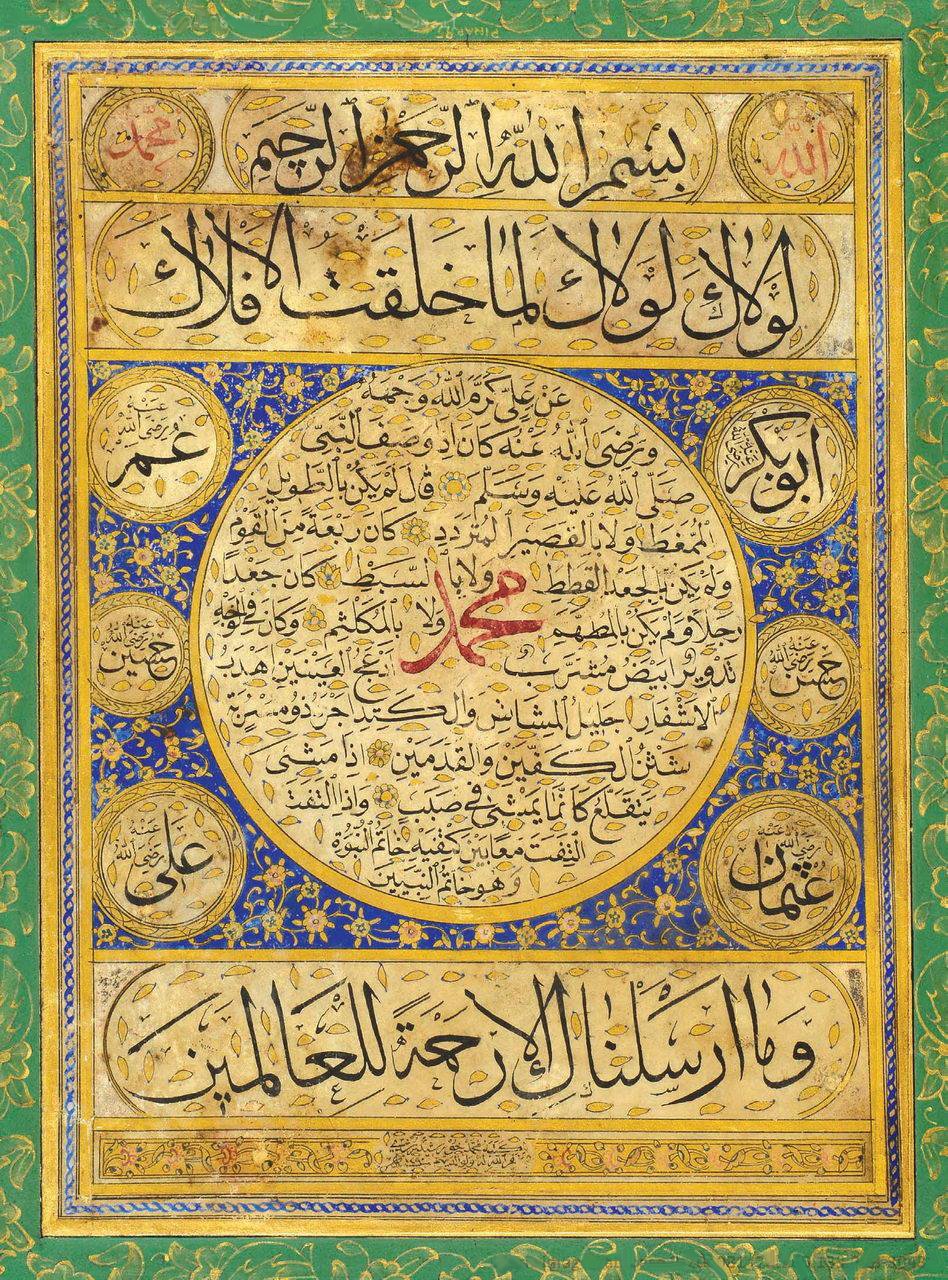The Golden Number is a product not of mathematical imagination, but of a natural principle related to the laws of equilibrium. We find the criteria of beauty according to Fibonacci is based on the laws of proportion. The 13th Century Italian Leonardo of Pisa, better known as Fibonacci, was by far the most talented Western mathematician of the Middle Ages. His introduction to Arabic numerals commenced at a young age during his stay in North Africa. It was Fibonacci who introduced Europe to the use of the Hindu-Arabic numeral system, describing its many benefits for merchants and mathematicians as a superior system to that of Roman numerals. By the 5th Century, Arabic prevailed making Roman numerals obsolete.
Inspired recently through a discussion with one of my teachers who hails from the House of Hashim through the descendants of Hasan al Askari, shed light on the subject of beauty and the Golden Ratio. The subject here is not the arithmetic aspect of the Golden Ratio but rather in light of beauty, balance and the human form as per Fibonacci’s theory and Leonardo Da Vinci’s depiction of the perfect man.
“Leonardo envisaged the great picture chart of the human body he had produced through his anatomical drawings and Vitruvian Man as acosmografia del minor mondo (cosmography of the microcosm). He believed the workings of the human body to be an analogy for the workings of the universe.”

In linking to Vituruvian Man, the Islamic tradition of describing the physical attributes of Mohammed (s), also known as Hilya, we find a common factor in all narrations; equilibrium as his natural state in form, character, mannerism and teachings. That said, the adherents of esoteric Islam believe in the Mohammedan Reality; Haqiqatul Mohammediya, which dwells upon his light being the first of all that was created,
“The first thing Allāh created is the light of Muhammad (s) and that light came and prostrated before Allāh. Allāh divided it into four parts and created from the first part the Throne, from the second the Pen, from the third the Tablet, and then similarly He subdivided the fourth part into parts and created the rest of creation. Therefore the light of the Throne is from the light of the Prophet (s), the light of the Pen is from the light of the Prophet (s), the light of the Tablet is from the light of the Prophet (s), the light of day, the light of knowledge, the light of the sun and the moon, and the light of vision and sight are all from the light of the Prophet (s).” [Al-Khātib Abū al-Rab‘i Muhammad ibn al-Layth in his book Shifā’ al-sudūr ]
The Muhammadan soul (al-rūh al-muhammadīyya) is therefore the quintessence of all created things and the first of them and their origin, as the Prophet said: I am from Allāh and the believers are from me, and Allāh created all souls from me in the spiritual world and He did so in the best form. It is the name of the totality of mankind in that primordial world, and after its creation by four thousand years, Allāh created the Throne from the light of Muhammad himself, and from it the rest of creation. The Muhammadan Light goes from prophet to prophet (min nabīyyin ila nabīyyin) until Allah (swt) causes it to emerge (akhraja) as the physical manifestation of the Prophet Muhammad (s) as the seal of the line of all prophets, yet first in the process of creation.
That said, we now go back to the concept of beauty as per the teachings of Fibonacci and Da Vinci. Given that the Creator is perfect, Flawless, Most Beautiful, thus His creation too reflects His beauty and Mohammed (s) being foremost to befit the Golden Ration criterion of human beauty. Creation perceived as a mirror of Divine beauty, we find man to be the most attractive of all creation. The magnetic power of the Prophet’s (s) beauty, both inner and outer, impacted all those who glanced upon him (s). These individuals became lovers of Mohammed (s), or lovers of Divine Light-Divine Light being this primordial Light; the Mohammedan (s) Light. This love phenomena carries on till today as has been the case of every era, even prior to his physical manifestation as known to us. Traditions state Adam sought forgiveness through Mohammed (s) whose name was written on the Divine throne. Prophets who came ‘before’ Mohammed (s) beseeched the Lord to appear as followers of his community in place of Prophethood. Such traditions are too numerous to share here. Aisha (r) the Prophet’s (s) wife, described the beauty of Mohammed (s) in comparison to Joseph who was known to possess half of the all created beauty in the following couplets based on the Qur’anic story of Joseph and the vizier’s wife, Zulaykha, whose friends cut their hands because they were mesmerized by his (Joseph)beauty:
‘If the women who saw Yusuf cut their hands seeing the beauty of Yusuf. They would have cut their throats if they saw my Yusuf. (referring to the prophet (s).
Imam al-Qurtubi in his book al-Salah explicates: “The perfection of the beauty of the Prophet (s), Allah’s peace and blessings be upon him, was not manifested to us fully; for, if it would have appeared in its entirety, our eyes wouldn’t have been able to observe him.”
Another from our Divaan of utterances, we share the same in terms of this mesmerising love,
The Light of Yusef
Yousef’s body thrown into a well
Zulaikha’s heart thrown into a bottomless well named Love
Yusef a Prophet
Zulaikha a plain mortal
Yusef jailed
Zulaikha blamed
His crime; innocence
Her crime; Love
I fell in love with Light
Through Yusef I saw Habib
Through Habib I saw Him
This light took over my being
My heart melted…
*Habib-among the names of Prophet Mohammed (s)
(copyright Qudra Healing)
Concluding the subject of this post, we come back to the Hilya, as a reflection of the beauty-criterion of the Golden Ratio. He, Mohammed (s) representing the personification of the Divine mirror, the ultimate manifestation of cosmic and celestial beauty!

The term hilya (Arabic حلية (plural: ḥilan, ḥulan), Turkish: hilye (plural: hilyeler) denotes a religious genre of Ottoman Turkish literature, dealing with the physical description of Muhammad. Hilya literally means “ornament”.
The Hilya Tradition
“God is Beautiful and He loves Beauty”
Hasan ibn Ali asked his maternal uncle Hind bin Abi Haalah about the description of the Messenger of Allah (sallallahu alayhi wa sallam). He said about his uncle that he was very capable of describing, he had given an excellent description of the Messenger of Allah (s). He said “I desired to hear this description from him because I wanted something to hold onto”.
Below is a transcript of Shaykh Hamza Yusuf’s lecture on the Description of the Prophet(S).
- He was very awe inspiring when you saw him.
- He was monumental, grand in nature when you saw him.
- His face was like a moon on laylatul badr. It had a light coming out of it like a moon on laylatul badr.
- He was taller than a moderate build but not exceedingly tall. If you see somebody very tall then it is strange even amongst tall people. If you see somebody short then it is also noticeable. He was of a middle stature inclining towards height because everything about him was middle.
- Even his physical description of colour was middle. He was not pasty white and he was not black. He was inclining towards light skin because of the racism of human beings. That is one of the hikmah of that. He was inclining towards light skin because of the racism of human beings. It has to do with the stupidity of human beings in distinguishing between people because of colour. He was a colour like what we call the harvest moon. He was not white nor dark, he was light skinned what we would call in English, a reddy complexion.
- His hair was neither straight or curly. It was wavy, it was middle. Everything about him was middle. He had a full head and his hair was wavy. If he parted it, it parted. It never went past the lobe of his ears if he allowed it to grow long because sometimes he would cut it for ibadah like the umrah or hajj. It went to the lobe or in some riwayah it went to the shoulder.
- He did not speak slow or fast. He spoke in a moderate tone. His words were neither too short nor excessive but they were always just right. When he spoke, people felt as it exactly the right amount of words were used. Everything about him was moderation.
- He had a large forehead which is an indication of high quality. He had a vein on his forehead. If he got upset they could see the vein.
- His eyebrows were full and there was a slight space between them.
- The upper part of his nose was aqualine. He had a beautiful nose that had a bridge on the upper part. He had a light that came from that area of his face that was clearly discernible.
- He had a full beard and his eyes were very dark.
- He had high beautiful cheek.
- He had a mouth that was full so when he spoke his pronunciation was perfect.
- His teeth were beautiful, there was a slight space in the teeth.
- He had a light hair on his chest which was manliness without having a lot of hair.
- His neck was like a gazelle’s neck. He had a beautiful neck and a high neck. It had like a beautiful silvery clarity to it.
- He was balanced in all of his outward aspects. He had a strong build and it was all perfectly formed.
- His stomach and chest were equal. He never had a large stomach. He had no paunch. Even when he was in his sixties, his stomach was always flat. He had light hair on his stomach. He had no hair over his breasts.
- He was full chested and his shoulders were broad. He had large bones.
- He had hair on his arms and he was sinewy and strong.
- There was a space in his trachea.
- His limbs were strong and he had full calves.
- His feet were very smooth. Because they were desert people and they walked a lot, their feet would have a lot of roughness to them. His feet were smooth that water would pour off them.
- When he walked, he walked softly but he was quick paced as if he was walking on an incline.
- When he looked at somebody, he did not just move his head, he turned his entire body to give full attention to that person.
- He looked more at the ground than he did up. His glance was generally down because of the power of his glance. When he looked at people, he did not maintain his stare. He would look then move away. As he looked at people, he never fixed his focus on people because of the effect that would have on people.